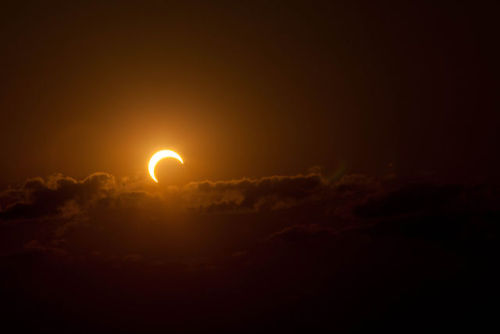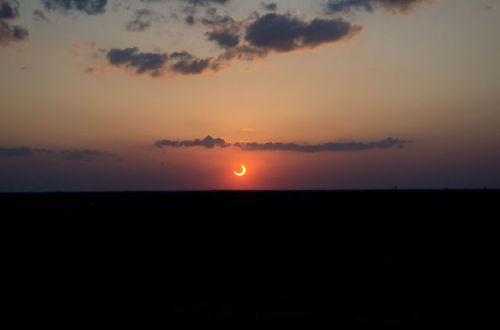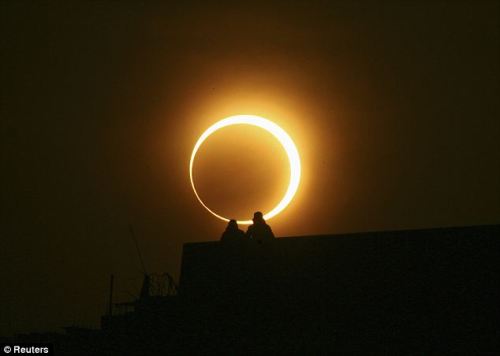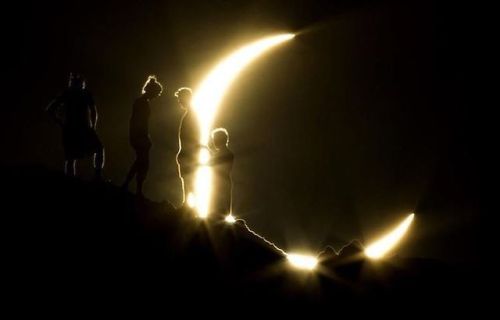A New Angle On Two Spiral Galaxies For Hubble’s 27th Birthday
A New Angle on Two Spiral Galaxies for Hubble’s 27th Birthday
In celebration of the 27th anniversary of the launch of NASA’s Hubble Space Telescope on April 24, 1990, astronomers used the legendary telescope to take a portrait of a stunning pair of spiral galaxies. This starry pair offers a glimpse of what our Milky Way galaxy would look like to an outside observer. The edge-on galaxy is called NGC 4302, and the tilted galaxy is NGC 4298. These galaxies look quite different because we see them angled at different positions on the sky. They are actually very similar in terms of their structure and contents. Image credit: NASA, ESA, and M. Mutchler (STScI) Read more NASA Media Usage Guidelines
More Posts from Fillthevoid-with-space and Others





When the sun sets on Stonehenge on the shortest day of the year, it’s rays align with several important stones. Twice a year, the streets of Manhattan also line up with the setting sun, a phenomenon dubbed “Manhattanhenge”. Really, most cities with grid systems will see a similar effect (though it’s most dramatic in cities with tall buildings and a view of the true horizon). You can use a great tool called The Photographer’s Ephemeris to find out the “henge” dates for your city grid - or even individual streets.
Yesterday, (Friday, January 24th) the sun lined up with New York Avenue, a street in DC that runs diagonally up to the White House. (The orange line indicates alignment with the setting sun).
I went out with our multimedia intern Meg Vogel, and captured some images of the sun setting in line with a rather Stonehenge-y sculpture that sits in the middle of that street.
Here are dates for sunset “henge” events in some cities this year:
Manhattan May 25th, July 17th
Philadelphia April 5th, September 6th
Washington DC March 18th, September 24th
Chicago March 16th, September 26th
Phoenix March 20th, September 22nd
Portland, OR March 18th, September 24th
Is your city/town a grid? When’s your henge?

30 Doradus, located in the heart of the Tarantula nebula, is the brightest star-forming region in our galactic neighborhood. The nebula resides 170,000 light-years away in the Large Magellanic Cloud. Links to very large images in comments.
js
Deep Space Gateway to Open Opportunities for Distant Destinations
NASA logo. March 29, 2017 NASA is leading the next steps into deep space near the moon, where astronauts will build and begin testing the systems needed for challenging missions to deep space destinations including Mars. The area of space near the moon offers a true deep space environment to gain experience for human missions that push farther into the solar system, access the lunar surface for robotic missions but with the ability to return to Earth if needed in days rather than weeks or months. The period of exploration in the vicinity of the moon will begin with the first integrated mission of the Space Launch System (SLS) rocket and the Orion spacecraft, and will continue as we explore further. NASA aims to begin a cadence of one flight per year after the second mission, and the agency has established an initial set of integrated human exploration objectives combining the efforts aboard the International Space Station, SLS and Orion, and other capabilities needed to support human missions to explore deep space. Flight hardware for SLS and Orion is currently in production for the first and second missions, life support and related technologies are being tested on ISS, and habitation and propulsion development activities are also underway. NASA is working with domestic and international partners to solve the great challenges of deep space exploration. Missions in the vicinity of the moon will span multiple phases as part of NASA’s framework to build a flexible, reusable and sustainable infrastructure that will last multiple decades and support missions of increasing complexity. Deep Space Gateway This first phase of exploration near the moon will use current technologies and allow us to gain experience with extended operations farther from Earth than previously completed. These missions enable NASA to develop new techniques and apply innovative approaches to solving problems in preparation for longer-duration missions far from Earth. In addition to demonstrating the safe operation of the integrated SLS rocket and Orion spacecraft, the agency is also looking to build a crew tended spaceport in lunar orbit within the first few missions that would serve as a gateway to deep space and the lunar surface. This deep space gateway would have a power bus, a small habitat to extend crew time, docking capability, an airlock, and serviced by logistics modules to enable research. The propulsion system on the gateway mainly uses high power electric propulsion for station keeping and the ability to transfer among a family of orbits in the lunar vicinity. The three primary elements of the gateway, the power and propulsion bus and habitat module, and a small logistics module(s), would take advantage of the cargo capacity of SLS and crewed deep space capability of Orion. An airlock can further augment the capabilities of the gateway and can fly on a subsequent exploration mission, Building the deep space gateway will allow engineers to develop new skills and test new technologies that have evolved since the assembly of the International Space Station. The gateway will be developed, serviced, and utilized in collaboration with commercial and international partners.
Lunar Space Station
“I envision different partners, both international and commercial, contributing to the gateway and using it in a variety of ways with a system that can move to different orbits to enable a variety of missions,” said William Gerstenmaier, associate administrator for Human Exploration and Operations at NASA Headquarters in Washington. “The gateway could move to support robotic or partner missions to the surface of the moon, or to a high lunar orbit to support missions departing from the gateway to other destinations in the solar system.” Deep Space Transport The second phase of missions will confirm that the agency’s capabilities built for humans can perform long duration missions beyond the moon. For those destinations farther into the solar system, including Mars, NASA envisions a deep space transport spacecraft. This spacecraft would be a reusable vehicle that uses electric and chemical propulsion and would be specifically designed for crewed missions to destinations such as Mars. The transport would take crew out to their destination, return them back to the gateway, where it can be serviced and sent out again. The transport would take full advantage of the large volumes and mass that can be launched by the SLS rocket, as well as advanced exploration technologies being developed now and demonstrated on the ground and aboard the International Space Station. This second phase will culminate at the end of the 2020s with a one year mission in the lunar vicinity to validate the readiness of the system to travel beyond the Earth-moon system to Mars and other destinations, and build confidence that long-duration, distant human missions can be safely conducted with independence from Earth. Through the efforts to build this deep space infrastructure, this phase will enable explorers to identify and pioneer innovative solutions to technical and human challenges discovered or engineered in deep space. To achieve the agency’s goal to extend humanity’s presence in the solar system will require the best research, technologies and capabilities from international partners and the private sector. NASA will look to partners for potential contributions of spaceflight hardware and the delivery of supplemental resources. The gateway and transport could potentially support mission after mission as a hub of activity in deep space near the moon, representing multiple countries and agencies with partners from both government and private industry. NASA is open to new ideas of both a technical and programmatic nature suggestions as we develop, mature and implement this plan. Related links: Journey to Mars: https://www.nasa.gov/topics/journeytomars/index.html Orion Spacecraft: https://www.nasa.gov/exploration/systems/orion/index.html Space Launch System (SLS): https://www.nasa.gov/exploration/systems/sls/index.html Image, Text, Credits: NASA/Kathryn Hambleton. Greetings, Orbiter.ch Full article
What's Made in a Thunderstorm and Faster Than Lightning? Gamma Rays!
A flash of lightning. A roll of thunder. These are normal stormy sights and sounds. But sometimes, up above the clouds, stranger things happen. Our Fermi Gamma-ray Space Telescope has spotted bursts of gamma rays - some of the highest-energy forms of light in the universe - coming from thunderstorms. Gamma rays are usually found coming from objects with crazy extreme physics like neutron stars and black holes.
So why is Fermi seeing them come from thunderstorms?

Thunderstorms form when warm, damp air near the ground starts to rise and encounters colder air. As the warm air rises, moisture condenses into water droplets. The upward-moving water droplets bump into downward-moving ice crystals, stripping off electrons and creating a static charge in the cloud.

The top of the storm becomes positively charged, and the bottom becomes negatively charged, like two ends of a battery. Eventually the opposite charges build enough to overcome the insulating properties of the surrounding air - and zap! You get lightning.

Scientists suspect that lightning reconfigures the cloud’s electrical field. In some cases this allows electrons to rush toward the upper part of the storm at nearly the speed of light. That makes thunderstorms the most powerful natural particle accelerators on Earth!

When those electrons run into air molecules, they emit a terrestrial gamma-ray flash, which means that thunderstorms are creating some of the highest energy forms of light in the universe. But that’s not all - thunderstorms can also produce antimatter! Yep, you read that correctly! Sometimes, a gamma ray will run into an atom and produce an electron and a positron, which is an electron’s antimatter opposite!

The Fermi Gamma-ray Space Telescope can spot terrestrial gamma-ray flashes within 500 miles of the location directly below the spacecraft. It does this using an instrument called the Gamma-ray Burst Monitor which is primarily used to watch for spectacular flashes of gamma rays coming from the universe.

There are an estimated 1,800 thunderstorms occurring on Earth at any given moment. Over the 10 years that Fermi has been in space, it has spotted about 5,000 terrestrial gamma-ray flashes. But scientists estimate that there are 1,000 of these flashes every day - we’re just seeing the ones that are within 500 miles of Fermi’s regular orbits, which don’t cover the U.S. or Europe.
The map above shows all the flashes Fermi has seen since 2008. (Notice there’s a blob missing over the lower part of South America. That’s the South Atlantic Anomaly, a portion of the sky where radiation affects spacecraft and causes data glitches.)

Fermi has also spotted terrestrial gamma-ray flashes coming from individual tropical weather systems. The most productive system we’ve seen was Tropical Storm Julio in 2014, which later became a hurricane. It produced four flashes in just 100 minutes!

Learn more about what Fermi’s discovered about gamma rays over the last 10 years and how we’re celebrating its accomplishments.
Make sure to follow us on Tumblr for your regular dose of space: http://nasa.tumblr.com.









A ‘Ring of Fire’ solar eclipse is a rare phenomenon that occurs when the moon’s orbit is at its apogee: the part of its orbit farthest away from the Earth. Because the moon is so far away, it seems smaller than normal to the human eye. The result is that the moon doesn't entirely block out our view of the sun, but leaves an “annulus,” or ring of sunlight glowing around it. Hence the term “annular” eclipse rather than a “total” eclipse.
-
 softcaet reblogged this · 8 years ago
softcaet reblogged this · 8 years ago -
 rutobuka2 liked this · 8 years ago
rutobuka2 liked this · 8 years ago -
 ironmanjax liked this · 8 years ago
ironmanjax liked this · 8 years ago -
 aeropajita reblogged this · 8 years ago
aeropajita reblogged this · 8 years ago -
 chronocreature liked this · 8 years ago
chronocreature liked this · 8 years ago -
 aeropajita reblogged this · 8 years ago
aeropajita reblogged this · 8 years ago -
 inexperiencedguy liked this · 8 years ago
inexperiencedguy liked this · 8 years ago -
 fmab reblogged this · 8 years ago
fmab reblogged this · 8 years ago -
 georgiagates17 liked this · 8 years ago
georgiagates17 liked this · 8 years ago -
 queer-pan reblogged this · 8 years ago
queer-pan reblogged this · 8 years ago -
 queer-pan liked this · 8 years ago
queer-pan liked this · 8 years ago -
 multifandom-fiasco liked this · 8 years ago
multifandom-fiasco liked this · 8 years ago -
 kindofarebelhideout-blog liked this · 8 years ago
kindofarebelhideout-blog liked this · 8 years ago -
 nimzzz reblogged this · 8 years ago
nimzzz reblogged this · 8 years ago -
 proteanstarstuff reblogged this · 8 years ago
proteanstarstuff reblogged this · 8 years ago -
 grnraptor liked this · 8 years ago
grnraptor liked this · 8 years ago -
 strife226 liked this · 8 years ago
strife226 liked this · 8 years ago -
 coopayu-blog liked this · 8 years ago
coopayu-blog liked this · 8 years ago -
 naked-or-not liked this · 8 years ago
naked-or-not liked this · 8 years ago -
 ixlsalvasia liked this · 8 years ago
ixlsalvasia liked this · 8 years ago -
 diomedeas reblogged this · 8 years ago
diomedeas reblogged this · 8 years ago -
 rjbailey reblogged this · 8 years ago
rjbailey reblogged this · 8 years ago -
 zemalia reblogged this · 8 years ago
zemalia reblogged this · 8 years ago -
 rjbailey liked this · 8 years ago
rjbailey liked this · 8 years ago -
 streetfightinman reblogged this · 8 years ago
streetfightinman reblogged this · 8 years ago -
 saw-yuki reblogged this · 8 years ago
saw-yuki reblogged this · 8 years ago -
 onlyham reblogged this · 8 years ago
onlyham reblogged this · 8 years ago -
 emmanuelvargassanchez-blog liked this · 8 years ago
emmanuelvargassanchez-blog liked this · 8 years ago -
 draconusumbra69 liked this · 8 years ago
draconusumbra69 liked this · 8 years ago -
 scrap-paper-origami reblogged this · 8 years ago
scrap-paper-origami reblogged this · 8 years ago -
 scrap-paper-origami liked this · 8 years ago
scrap-paper-origami liked this · 8 years ago -
 r3ds3rpent liked this · 8 years ago
r3ds3rpent liked this · 8 years ago -
 rukathetransformer liked this · 8 years ago
rukathetransformer liked this · 8 years ago -
 kaar-ne reblogged this · 8 years ago
kaar-ne reblogged this · 8 years ago -
 kaar-ne liked this · 8 years ago
kaar-ne liked this · 8 years ago -
 handsapt reblogged this · 8 years ago
handsapt reblogged this · 8 years ago -
 musanocturnis liked this · 8 years ago
musanocturnis liked this · 8 years ago -
 mrcat032 liked this · 8 years ago
mrcat032 liked this · 8 years ago -
 panchitoz reblogged this · 8 years ago
panchitoz reblogged this · 8 years ago -
 jeanettecoon liked this · 8 years ago
jeanettecoon liked this · 8 years ago -
 blue-pachyderm reblogged this · 8 years ago
blue-pachyderm reblogged this · 8 years ago -
 lordpudi reblogged this · 8 years ago
lordpudi reblogged this · 8 years ago -
 clisappointment reblogged this · 8 years ago
clisappointment reblogged this · 8 years ago
A podcast project to fill the space in my heart and my time that used to be filled with academic research. In 2018, that space gets filled with... MORE SPACE! Cheerfully researched, painstakingly edited, informal as hell, definitely worth everyone's time.
243 posts






